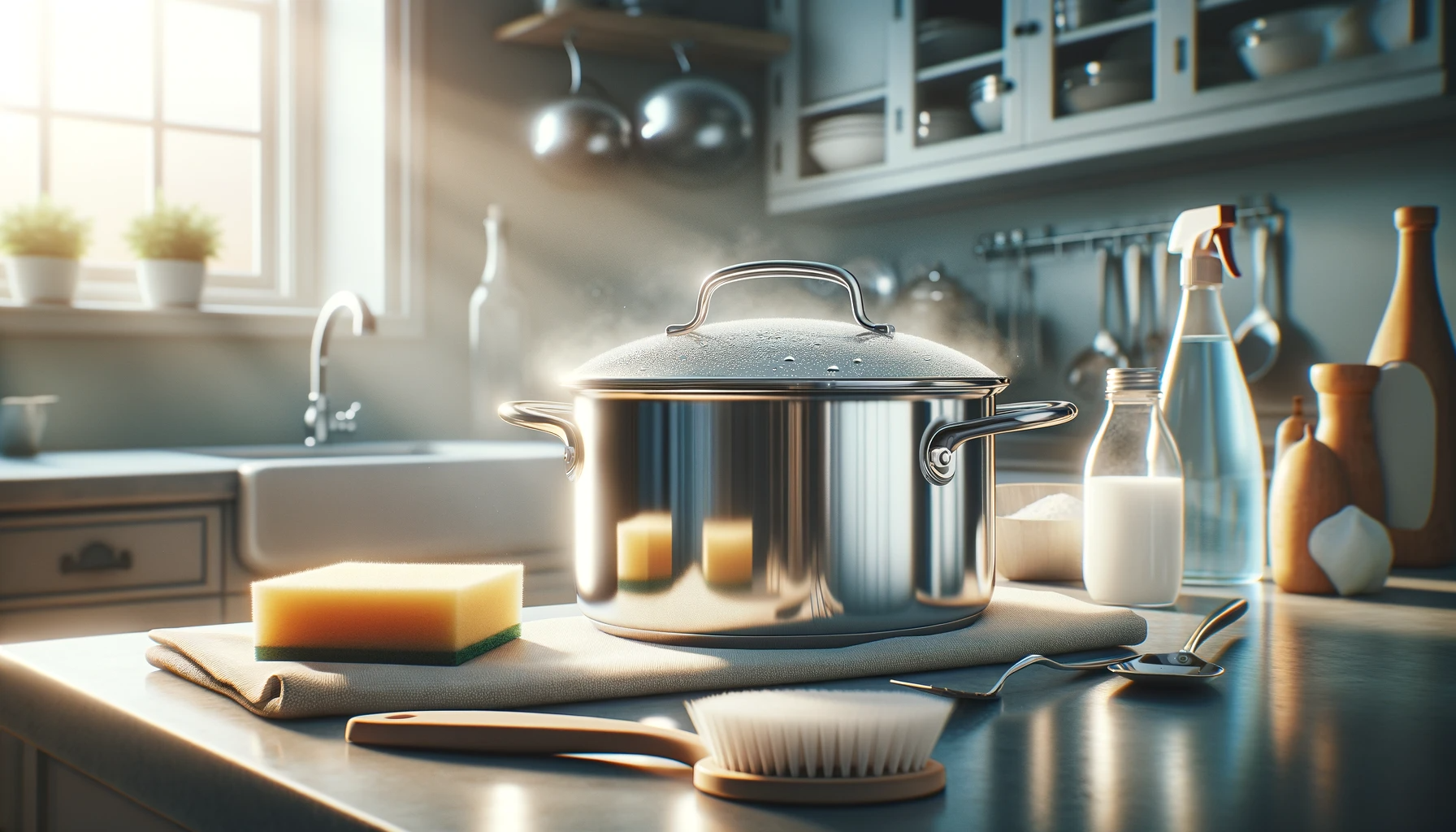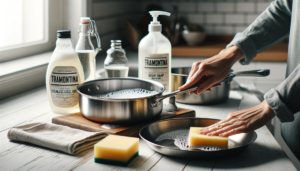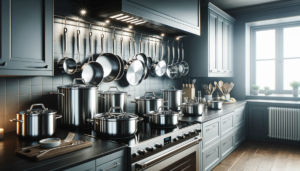Nothing ruins an expensive set of stainless steel pots and pans like discolorations and stains that build up over time.
But before you relegate them to the thrift store, learn simple tricks to have them looking showroom shiny again.
This article explores what causes cookware staining and provides a full guide on removing tough heat tint, food residue, hard water spots and even rust from stainless steel surfaces using common household cleaners and commercial products so your pans get revived.
Let’s dive in and break down what gives stainless steel that worn, dull look and how to brighten things up…
How to Clean Discoloration on Stainless Steel Cookware?

The easiest way to clean discoloration on stainless steel cookware is by making a paste of baking soda and water.
Apply the paste to stained areas and let sit briefly before gently scrubbing with a soft sponge or cloth.
Rinse thoroughly afterwards.
Baking soda is mildly abrasive so lifts stains effectively.
Below we’ll explore this method and other solutions like vinegar, Bar Keepers Friend and more for removing tough heat tint, mineral deposits, food residue and rust stains from stainless steel pans and pots.
What Causes Staining on Stainless Steel Pans?

Before exploring how to remove stains from stainless steel, it’s helpful to understand what causes them in the first place.
There are four main culprits that create discoloration on stainless pans and pots:
Heat Tinting – This refers to bluish, brown, rainbow or yellow discoloration that occurs when an empty stainless steel pan is overheated.
As the metal heats to extreme temperatures, its protective chromium oxide layer breaks down and the steel undergoes an alteration in color.
Food Stains – Pots and pans that aren’t thoroughly cleaned after cooking can develop baked-on stains from ingredients like tomatoes, garlic, onions, oil, spices, egg, pasta sauce and so forth.
Food residue essentially gets carbonized onto the surface, leaving darkened spots.
Hard Water Stains – The mineral content in hard tap water leaves behind chalky deposits when allowed to dry on stainless steel cookware.
This creates spotting, cloudiness and whitish buildup on the bottoms and sides of pans.
Rust Stains – While stainless steel contains chromium to resist corrosion, it can still rust under certain conditions of excess moisture or exposure to salt water or briny foods.
This leads to reddish-brown staining.
Types of Stains on Stainless Steel Cookware
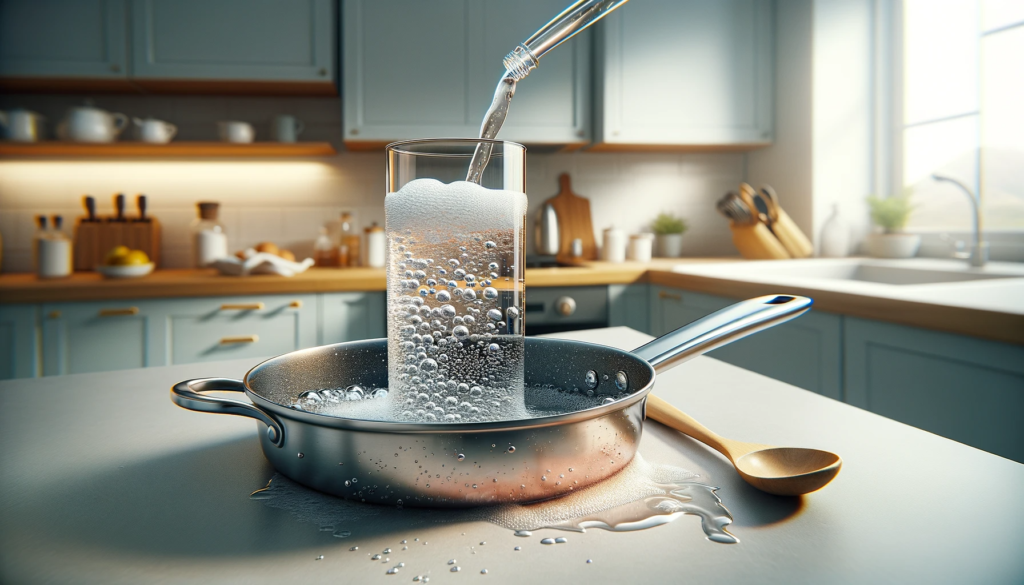
Now let’s explore the most typical stains that occur on stainless pots and pans so you know what you’re dealing with if discoloration occurs.
Heat Tint
When stainless steel is exposed to extremely high heat, the properties of the metal itself start to transform.
Heating an empty pan causes the protective chromium oxide layer to break down, allowing the underlying steel to react with oxygen which alters its color.
The end result is commonly referred to as heat tint.
Tinting on stainless steel spans a range of hues including yellow, brown, blue, purple and even a rainbow effect.
It occurs in places that reach the highest temperatures, normally the bottom and lower sides of a pot or pan.
Tinting alone doesn’t necessarily damage the pan, but it can be unpleasant to look at overtime.
Luckily, heat tint can be removed to restore stainless to its original pristine, silvery color using some of the cleaning methods detailed later in this article.
Food Stains
Stainless steel is highly prone to staining from certain cooked-on foods.
Ingredients like tomatoes, oils, spices, garlic, onions and sauces essentially get baked onto the surface of pots and pans during heating.
Overtime with continued cooking, polymerized films form leading to stubborn discoloration that can be tricky removing.
Food stains normally appear as darkened patches of gold, brown or orange.
They are usually most noticeable on the bottom and lower sides of a pan where food residues have charred on.
If not dealt with promptly, burnt on food can carbonize and become increasingly hard to eliminate.
Thankfully, even dried, stubborn food stains can be lifted using specialty cleaners and stain removers made for stainless steel which will be covered further below.
Hard Water Stains
Hard water is the culprit behind whitish spots and film that builds up on stainless steel over repeat usage and hand washings.
The high mineral content including calcium, magnesium and iron leave behind chalky mineral deposits as water droplets evaporate.
These dried mineral residues create cloudiness, streaking and spotting on stainless steel surfaces.
Hard water stains tend to concentrate on the sides of pots and pans but can occur anywhere water rests and then evaporates.
While unsightly, hard water staining is fairly simple to treat using natural acidic solutions or commercial cleansers formulated specifically for dissolving mineral deposits.
Rust Stains
Stainless steel contains chromium which gives it excellent corrosion resistance compared to other types of steel.
However, it is still made with iron so rust formation is possible under certain conditions.
When stainless steel pans are left wet for prolonged periods, exposed to salt water from cooking or brined foods, or abraded from scouring, surface rust can develop.
This manifests as reddish-brown staining on the pan.
If left untreated, pitting and extensive corrosion could occur.
Thankfully surface level rust on stainless steel generally comes off with some elbow grease and the right rust removal techniques.
But prevention is also key to avoid permanent damage.
Cleaning Methods
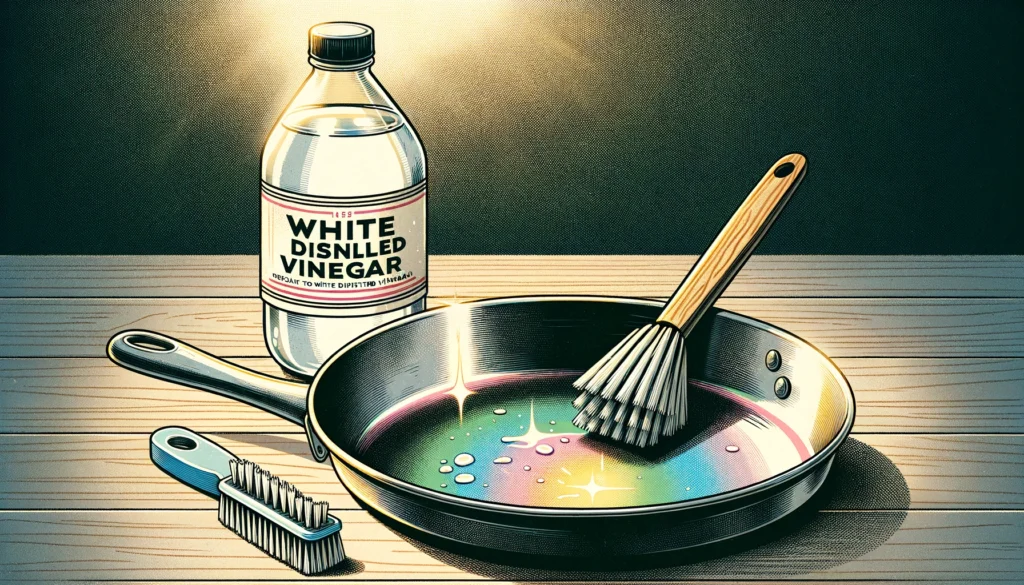
Now that you know what causes stainless steel pans to become tinted, stained or spotted, let’s cover the techniques for restoring their pristine finish.
From common pantry staples to commercial cleaners, you have options for tackling all types of discoloration issues.
Here are some of the most effective methods with tips for usage.
Baking Soda and Water Paste
Baking soda is a mildly abrasive natural cleaner that lifts stains off surfaces through gentle scouring action.
Mixed with a little water into a spreadable paste, it can scrub away discoloration without scratching stainless steel.
To use this method:
- Stir 3-4 tablespoons of baking soda with just enough water to form a thick paste
- Using a soft cloth, rub the paste thoroughly over stained areas
- Let sit for 2-3 minutes before rinsing
- Scrub gently while rinsing to help lift stains
- Dry completely with a soft towel
Repeat if needed for tough stains.
Baking soda paste removes heat tinting, food residues, hard water spots and some rust stains on stainless pots and pans.
White Distilled Vinegar
The acetic acid in distilled white vinegar works well for dissolving mineral deposits, soap scum and some carbonized food stains on stainless steel cookware.
To employ this cleaning solution:
- Liberally pour undiluted vinegar over stained areas
- Let soak for 15-30 minutes
- Scrub with a plastic bristle brush or sponge
- Rinse thoroughly and wipe completely dry
Since vinegar is acidic, you must rinse it off entirely after usage to avoid pitting or corrosion damage to cookware.
Club Soda
Plain carbonated water in the form of club soda contains carbon dioxide, which creates a fizzing effect on stains.
This helps lift mineral deposits and food residues.
To put it to work cleaning stainless pans:
- Pour club soda liberally over stained areas
- Let fizz for a few minutes before scrubbing with a sponge
- Rinse and dry thoroughly after cleaning
Keep in mind seltzer water loses its bubbles quickly, so work in sections and rinse promptly once fizzing stops.
The abrasive action also helps remove stuck on gunk.
Bar Keepers Friend
This commercial cleanser powder is formulated specifically for cleaning stainless steel cookware as well as other metals.
It leverages the stain-fighting power of oxalic acid to break down mineral deposits and also lift heat tint.
To wield its cleaning power:
- Sprinkle the powder onto stained pans
- Add water to form a thick paste
- Apply paste and let sit 1-2 minutes
- Gently scrub with a damp sponge in circular motions
- Rinse thoroughly and immediately dry cookware
Since Bar Keepers Friend contains harsh acids, strictly follow package directions and ensure to wash residue off entirely after usage.
Bleach Cleaner
For the toughest baked on stains, a diluted 50/50 bleach and water solution can help lift discoloration.
Make sure to rinse thoroughly after use.
Here’s how:
- In a spray bottle combine:
- 1 cup bleach
- 1 cup cool water
- Mist or wipe solution onto stained areas
- Let sit briefly before scrubbing with a plastic abrasive sponge
- Wash and rinse several times until bleach smell dissipates
- Immediately dry cookware with a towel
Repeat process if needed but avoid overuse of bleach directly on stainless steel to prevent corrosion over time.
Electrolytic Rust Removal
For significant rust staining, electrolytic cleaning efficiently removes corrosion on stainless steel.
This process uses an electric current, a conductive solution and a sacrificial metal tool or “anode” to essentially dissolve rust away.
Since electrolytic systems can be dangerous if done incorrectly, it’s best left to professional kitchen supply restorers.
But in a pinch you can try it cautiously at home.
Prevention Tips
- Always hand dry stainless steel pans after washing, don’t let air dry
- Rub a small amount of cooking oil into cookware after drying
- Use distilled white vinegar in your dishwashing cycle to prevent spots
- Avoid overheating empty stainless steel pans
- Don’t use highly abrasive scouring pads which could scratch
- Wash pans after cooking highly staining foods like tomatoes
- Periodically polish with stainless steel cleaner
Following these simple habits will help keep your stainless steel pots and pans looking shiny and pristine for years to come!
When to Replace Stained Cookware

While the cleaning methods described in this article can rejuvenate stained stainless steel pots and pans, at a certain point cookware becomes too worn to salvage.
Here are some signs it might be time to retire stained pans:
- Pitting, heavy scratching or gouges in the steel
- Warping and distortion of the pan bottom
- Rust that penetrates below surface level
- Thick mineral scale impossible to remove
- Permanent heat tint colors
Well-maintained stainless steel cookware can last for decades.
But at some juncture it makes sense to replace extremely stained and damaged pots and pans.
Conclusion
With this comprehensive guide, you now understand the common causes of stainless steel cookware staining and have a veritable arsenal of cleaning techniques to restore their original pristine finish.
While stained pans might seem destined for the trash, often they can be revived to like-new condition with a little labor and the right stainless steel cleaners.
Remember to thoroughly wash pans after cooking, dry immediately, and repeat cleaning procedures for stubborn blemishes.
With proper care and maintenance, your expensive stainless steel pots and pans should provide many years of durable cooking performance before replacements become necessary.
So try these staining removal methods before throwing in the towel!
